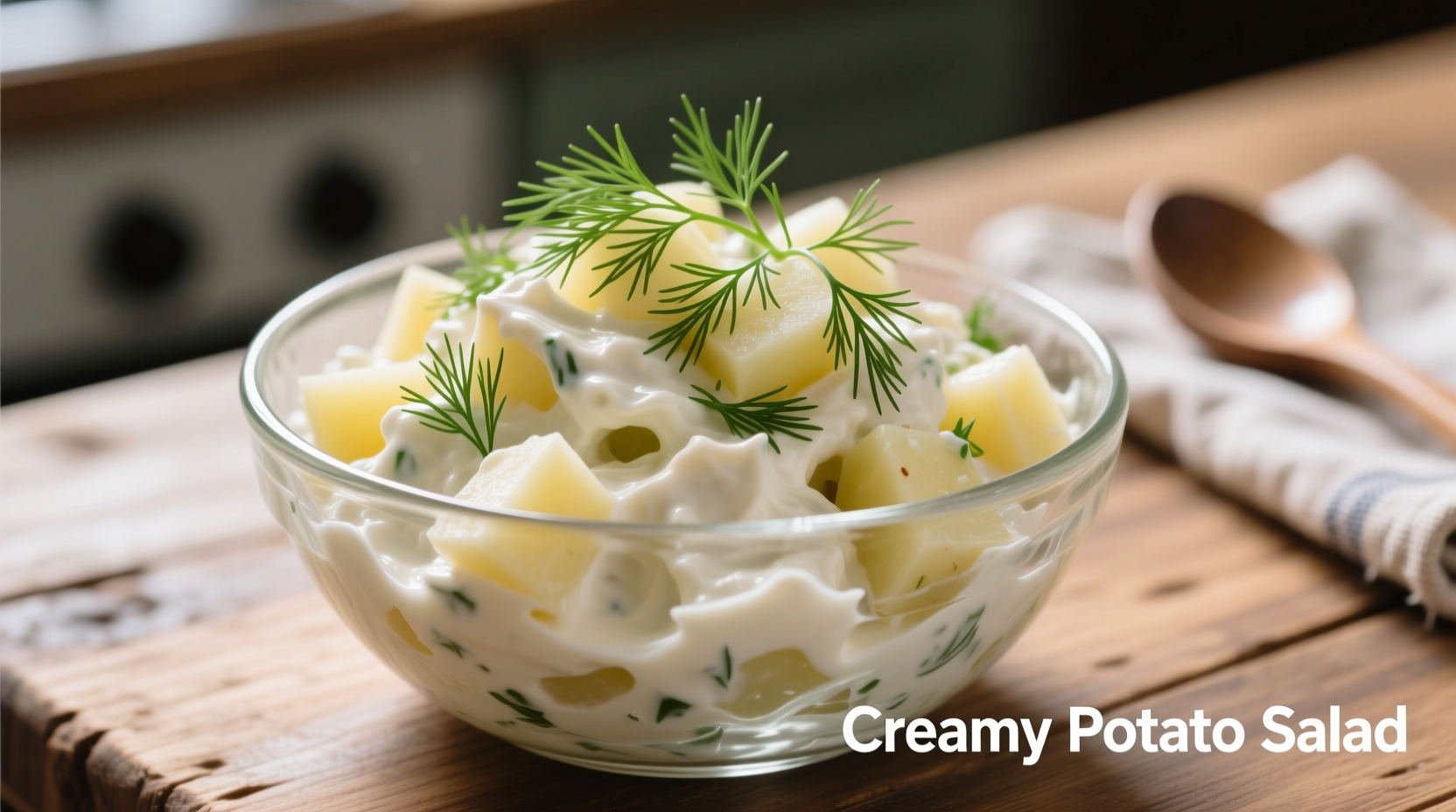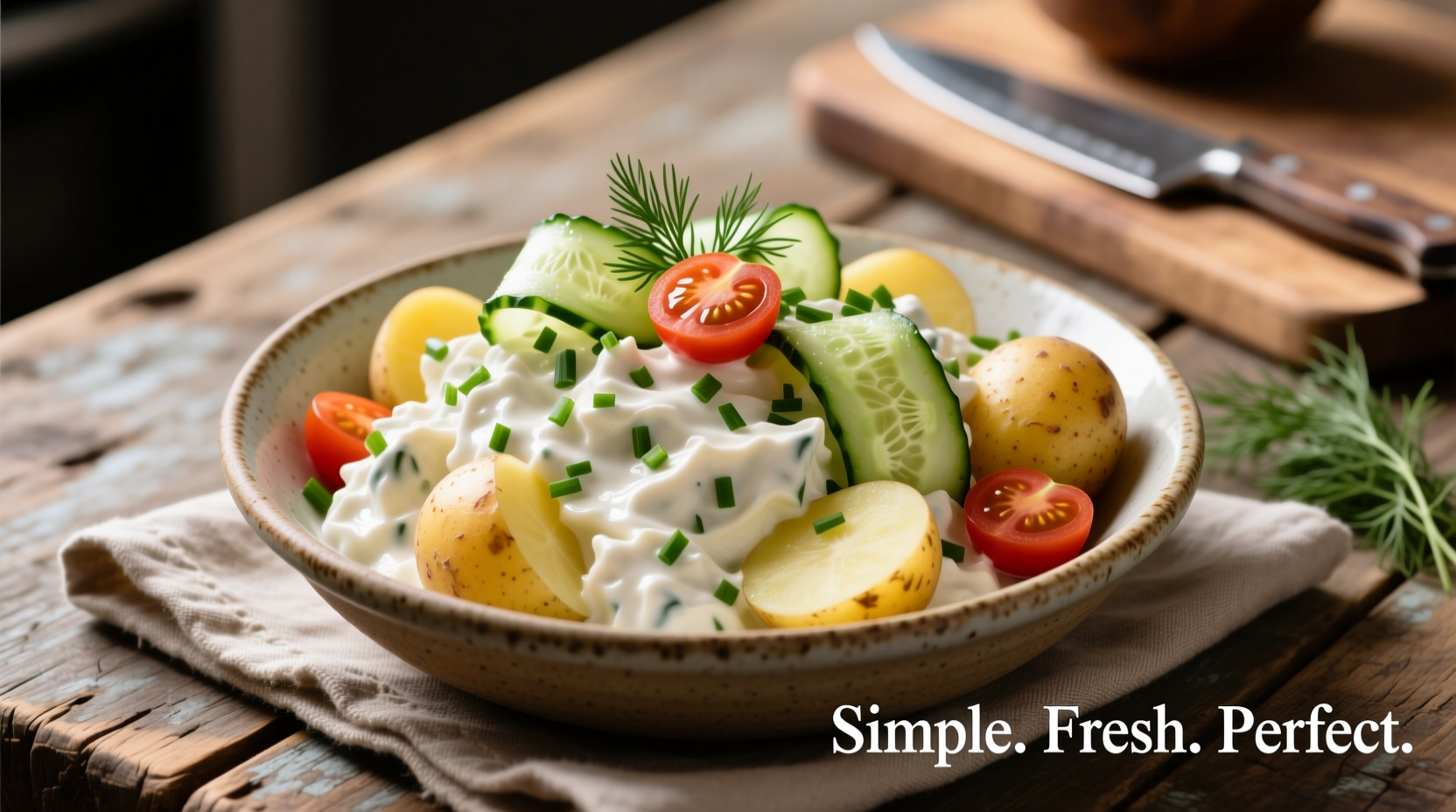White potato salad uses waxy potatoes like Yukon Gold or red potatoes that hold their shape when cooked, creating a creamier texture with a subtle sweetness compared to traditional russet-based potato salads. The best versions feature a balanced dressing of mayonnaise, mustard, and vinegar with fresh herbs and just-cooked potatoes that absorb flavors perfectly.
Craving a potato salad that's creamy without being heavy, flavorful without overpowering the delicate potato flavor? You've come to the right place. As a chef specializing in European culinary traditions, I've perfected this white potato salad recipe through years of testing different potato varieties, dressing ratios, and preparation techniques. Whether you're preparing for a summer barbecue, potluck, or simply want a satisfying side dish, this guide delivers restaurant-quality results every time.
Why White Potatoes Make the Perfect Salad Base
Not all potatoes behave the same when boiled and mixed with dressing. White potatoes—specifically waxy varieties like Yukon Gold, red bliss, or new potatoes—contain less starch than russets, which means they maintain their shape during cooking and create a creamier mouthfeel without becoming mushy. This characteristic makes them ideal for potato salad where texture is crucial.
| Potato Type | Starch Content | Texture After Cooking | Best For |
|---|---|---|---|
| Yukon Gold | Medium | Creamy yet firm | Ideal for potato salad |
| Red Bliss | Low | Firm, holds shape | Classic potato salad |
| Russet | High | Fluffy, breaks down | Mashed potatoes, not salad |
| Fingerling | Low | Firm, distinctive shape | Gourmet presentations |
According to the Saskatchewan Ministry of Agriculture, waxy potatoes contain 16-18% dry matter compared to 20-22% in starchy varieties, explaining their superior performance in cold salads. This scientific distinction matters when you're aiming for that perfect bite where the potato maintains integrity while absorbing dressing flavors.
The Evolution of Potato Salad: From European Roots to American Classic
Potato salad's journey reflects culinary adaptation across continents. Originally developed in 18th century Germany with vinegar-based dressings, the dish transformed when German immigrants brought it to America in the 19th century. The addition of mayonnaise created the creamy version we know today, while regional variations emerged:
- 1700s: German potato salad appears with vinegar, bacon, and mustard dressing, served warm
- 1840s: German immigrants introduce the dish to America, where it becomes popular at picnics
- Early 1900s: Mayonnaise becomes widely available, leading to the creamy American version
- 1930s: Potato salad becomes a staple at American summer gatherings and delis
- Present day: Regional variations flourish, from Southern sweet potato salads to German-style vinegar dressings
This historical context explains why white potato salad works particularly well—it bridges the European tradition of using waxy potatoes with the American preference for creamy dressings.
Essential Ingredients for Perfect White Potato Salad
The magic of exceptional white potato salad lies in ingredient quality and proper ratios. Here's what you'll need for a classic version serving 6-8 people:
| Ingredient | Amount | Why It Matters |
|---|---|---|
| Yukon Gold potatoes | 2 lbs, unpeeled | Natural buttery flavor, perfect texture |
| Mayonnaise | 1 cup | Use full-fat for best texture and flavor |
| Dijon mustard | 2 tablespoons | Adds complexity without overpowering |
| White wine vinegar | 1 tablespoon | Brightens flavors, balances richness |
| Red onion | 1/4 cup finely diced | Milder than yellow onion, adds color |
| Fresh dill | 2 tablespoons chopped | Essential herbal note, don't substitute dried |
| Celery | 1/2 cup finely diced | Adds crunch and freshness |
| Hard-boiled eggs | 2, chopped | Traditional addition for richness |
| Salt and pepper | To taste | Season in layers for best results |

Step-by-Step Preparation: The Professional Chef's Method
Follow these precise steps for potato salad that maintains perfect texture and flavor balance:
1. Potato Preparation: The Critical First Step
Cut potatoes into uniform 3/4-inch cubes while leaving skins on for added texture and nutrients. Place in a large pot, cover with cold water by 1 inch, and add 1 tablespoon salt. Bring to a gentle boil, then reduce heat to maintain a simmer. Cook for 12-15 minutes until tender but still slightly firm when pierced with a fork—not fully cooked through. This is crucial: potatoes will continue cooking from residual heat.
Drain potatoes immediately and spread on a baking sheet to cool slightly. While still warm (but not hot), transfer to a large mixing bowl. This warm-but-not-hot stage is essential for optimal dressing absorption without becoming mushy.
2. Dressing Technique: Building Flavor Layers
In a separate bowl, whisk together mayonnaise, Dijon mustard, vinegar, 1 teaspoon salt, and 1/2 teaspoon black pepper. Pour half the dressing over the warm potatoes and gently fold to coat. This initial coating allows the potatoes to absorb flavor while they finish cooling. Let sit for 10 minutes before adding remaining ingredients.
3. Final Assembly: Texture and Temperature Matters
Add red onion, celery, hard-boiled eggs, and fresh dill to the dressed potatoes. Pour remaining dressing over the mixture and gently combine. Cover and refrigerate for at least 2 hours (but no more than 4) before serving. This resting period allows flavors to meld while maintaining distinct textures.
According to food science research from the USDA National Institute of Food and Agriculture, the optimal serving temperature for potato salad is between 40-45°F (4-7°C). Serving too cold dulls flavors, while warmer temperatures risk both texture degradation and food safety concerns.
Common Mistakes to Avoid
Even experienced cooks make these critical errors that compromise white potato salad quality:
- Using the wrong potato variety - Russets break down too easily, creating a mushy texture
- Overcooking the potatoes - They should be tender but still hold their shape
- Adding dressing to hot potatoes - Causes mayonnaise to break and potatoes to become waterlogged
- Skipping the resting period - Flavors need time to meld for optimal taste
- Using dried herbs instead of fresh - Fresh dill makes a significant flavor difference
Variations to Suit Different Occasions
Once you've mastered the classic version, try these professional variations:
- Lighter version: Replace half the mayonnaise with Greek yogurt and add lemon zest
- Herb-forward version: Increase fresh herbs to 1/4 cup total (dill, parsley, chives)
- Mustard variation: Use whole grain mustard for texture and tang
- Crunchy element: Add 1/4 cup diced pickles or capers for brightness
- Protein boost: Fold in 1/2 cup diced cooked bacon or smoked salmon
For special dietary needs, the Harvard T.H. Chan School of Public Health recommends substituting avocado for half the mayonnaise to reduce saturated fat while maintaining creaminess.
Serving Suggestions and Storage Tips
White potato salad shines as a versatile side dish that complements many main courses:
- Perfect with grilled chicken, fish, or burgers
- Excellent alongside smoked meats at barbecue gatherings
- Works well as part of a brunch spread with quiche and fruit
- Serve in lettuce cups for a lighter presentation option
For optimal freshness, store in an airtight container in the refrigerator for up to 3 days. The dressing may separate slightly—simply stir gently before serving. Never leave potato salad at room temperature for more than 2 hours (1 hour if temperatures exceed 90°F/32°C) to prevent bacterial growth.
Why This Recipe Delivers Consistent Results
What separates this white potato salad from others? The precise attention to potato variety selection, cooking temperature control, and dressing application timing creates a dish that's consistently creamy yet textured, flavorful without being overpowering. The balance of acidity from vinegar and mustard cuts through the richness of the mayonnaise, while the fresh herbs provide brightness that elevates the entire dish.
Unlike many recipes that simply throw ingredients together, this method respects the science of how potatoes interact with dressings at different temperatures. The result is a potato salad that maintains its integrity through serving and storage—never watery, never mushy, always flavorful.











 浙公网安备
33010002000092号
浙公网安备
33010002000092号 浙B2-20120091-4
浙B2-20120091-4